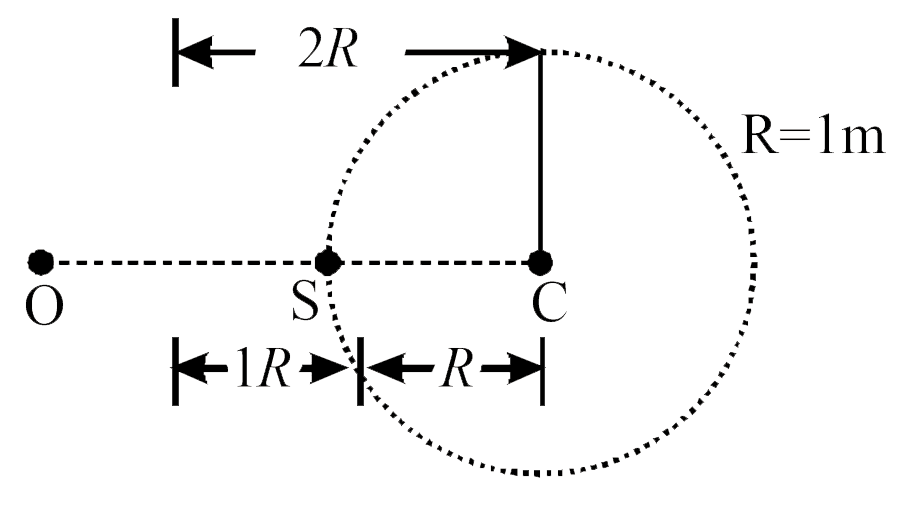Sound from a point isotropic source spreads equally in all directions in homogeneous medium. Therefore its intensity decreases with square of distance from the source. When distance between observer and the source changes, apart from changes in intensity, the observer listens sound of pitch higher or lower than actual pitch depending upon the fact that the distance between the observer and source is decreasing or increasing respectively. An observer O is at a distance 2R from centre of a circle of radius R. A point isotropic sound source S moves on the circle with uniform angular velocityω=π/3 rad/s. Initially observer, source and centre of the circle are in same line.

During a complete round trip of star on the circle, the observer listens a sound, whose –
wavelength first decreases to a maximum value then increases to the original value
wavelength first increases to a maximum value then decreases to the original value
During the first half time wavelength increases then decreases to the original value
None of the above is correct because in Doppler's effect, it is the pitch of sound which changes and not its wavelength, irrespective of motion of source or observer.
Step by step video & image solution for Sound from a point isotropic source spreads equally in all directions in homogeneous medium. Therefore its intensity decreases with square of distance from the source. When distance between observer and the source changes, apart from changes in intensity, the observer listens sound of pitch higher or lower than actual pitch depending upon the fact that the distance between the observer and source is decreasing or increasing respectively. An observer O is at a distance 2R from centre of a circle of radius R. A point isotropic sound source S moves on the circle with uniform angular velocityomega = pi//3 " rad"//s. Initially observer, source and centre of the circle are in same line. During a complete round trip of star on the circle, the observer listens a sound, whose – by Physics experts to help you in doubts & scoring excellent marks in Class 12 exams.
Updated on:21/07/2023Similar Questions
Sound from a point isotropic source spreads equally in all directions in homogeneous medium. Therefore its intensity decreases with square of distance from the source. When distance between observer and the source changes, apart from changes in intensity, the observer listens sound of pitch higher or lower than actual pitch depending upon the fact that the distance between the observer and source is decreasing or increasing respectively. An observer O is at a distance 2R from centre of a circle of radius R. A point isotropic sound source S moves on the circle with uniform angular velocityω=π/3 rad/s. Initially observer, source and centre of the circle are in same line.

Sound emitted by the source at two successive instants t1 and t2 has minimum and maximum observed pitch respectively, then –
View SolutionSound from a point isotropic source spreads equally in all directions in homogeneous medium. Therefore its intensity decreases with square of distance from the source. When distance between observer and the source changes, apart from changes in intensity, the observer listens sound of pitch higher or lower than actual pitch depending upon the fact that the distance between the observer and source is decreasing or increasing respectively. An observer O is at a distance 2R from centre of a circle of radius R. A point isotropic sound source S moves on the circle with uniform angular velocityω=π/3 rad/s. Initially observer, source and centre of the circle are in same line.

Starting from initial moment, the source moves through an angular displacement 180∘. Intensity of the sound as observed by the observer decreases by a factor of –
View Solution
Knowledge Check
If the distance between the observer and source decresase with time, then it show that
Aappartment frequency will be less than actual frequencyBappartment frequency will be greater than actual frequencyCappartment frequency will be equal to the actual frequencyDapparent frequencies cannot be noticedIntensity of sound at a point is its distance from the source
Adirectly proportional toBinversely proportional toCdirectly proportional to square ofDinversely proportional to square ofIf the distance between the screen and the sources is decreased by 25%, then the change in fringe width is
A25% decreaseB25% increaseC75% increaseD75% decrease
The intensity of light at a distance 'r' from the axis of a long cylindrical source is inversely proportional to 'r'
View SolutionIntensity of sound at a point is its distance from the source
View SolutionA point source emits sound equally in all directions in a non-absorbing medium. Two point P and Q are at distance of 2m and 3m respectively from the source. The ratio of the intensities of the wave at P and Q is :
View SolutionA point source emits sound equally in all directions in a non-absorbing medium. Two point P and Q are at distance of 2m and 3m respectively from the source. The ratio of the intensities of the wave at P and Q is :
View SolutionA source of sound moves towards an observer
View Solution

